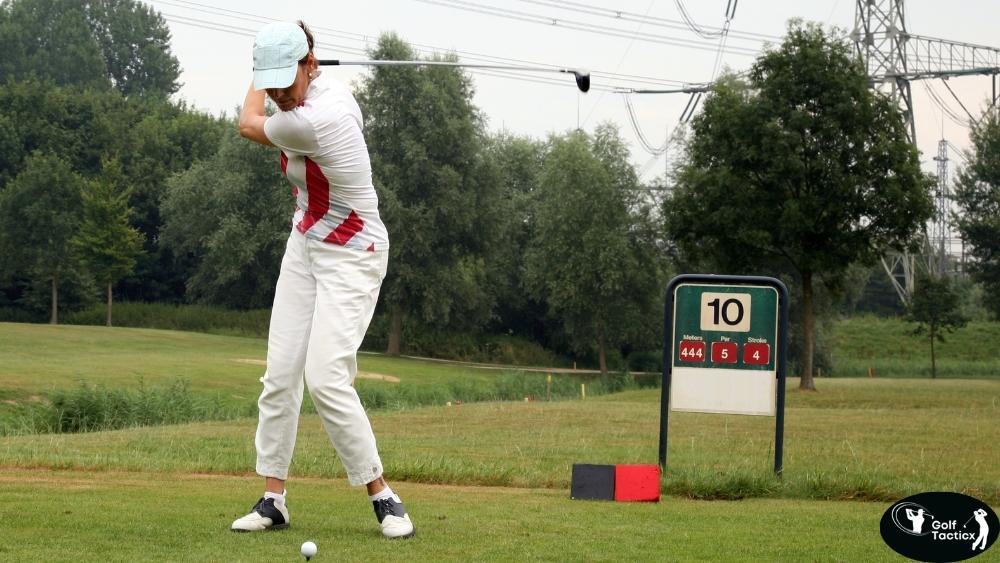In our previous posts, we’ve explored What’s the best way to escape deep rough without losing control? Today, we’re focusing on a crucial skill that can make a significant difference in your game: hitting a punch shot to escape trees or low obstacles. Mastering the punch shot is essential for navigating challenging course conditions and enhancing your overall performance.
Golf is a game that requires precision, strategy, and the ability to adapt to various challenges on the course. One of the most effective techniques for handling these challenges, especially when faced with obstacles like trees or bunkers, is the punch shot technique for clearing obstacles in golf. This shot, when executed properly, allows golfers to maintain control over the ball’s trajectory while navigating around obstacles that would otherwise affect their game. In this article, we’ll delve into the details of the punch shot technique, explaining its purpose, how to execute it, and when it’s most useful.
Understanding the Punch Shot Technique
The punch shot technique for clearing obstacles in golf is a low-trajectory shot that is typically used to avoid overhead obstacles like tree branches or to stay under the wind. By keeping the ball’s flight path low and controlled, you reduce the risk of hitting an obstacle and gain more accuracy, which is critical in tight situations.
This technique involves a more compact swing compared to a standard shot. The primary goal is to control the trajectory of the ball, making it fly lower to the ground while still covering a reasonable distance. It’s especially useful when you’re faced with trees, tall grass, or even a bunker that could otherwise interfere with your shot.
Key Elements of the Punch Shot Technique
To successfully execute the punch shot technique for clearing obstacles in golf, you need to focus on several key elements:
Grip and Setup
The grip for a punch shot should be slightly firmer than usual to reduce the chances of the clubface turning. As for the setup, it’s important to adopt a more forward ball position. Place the ball slightly back in your stance and ensure that your hands are slightly ahead of the ball at address. This setup encourages a more downward strike, promoting a lower ball flight.
Stance and Posture
To execute a punch shot, adopt a slightly narrower stance. This stance helps in maintaining balance while allowing you to control the shot. Keep your weight slightly forward, leaning towards your left leg (for right-handed players) to help you strike the ball cleanly.
Swing Technique
Unlike a standard full swing, the punch shot requires a more abbreviated backswing. The goal is to avoid too much wrist action and keep the club on a more straight path through the ball. The follow-through should also be short, keeping the trajectory low and controlled. Keep your body rotation to a minimum and focus on making solid contact with the ball. The punch shot relies more on hand-eye coordination and a stable swing path than sheer power.
Club Selection
The type of club you choose for the punch shot depends on the distance and the height of the obstacle. Generally, golfers use a 5-iron or 6-iron for this shot, but the key is to select a club that helps you control the trajectory. A lower lofted iron will generally produce a more penetrating ball flight, which is perfect for clearing obstacles.
When to Use the Punch Shot in Golf
Knowing when to use the punch shot technique for clearing obstacles in golf is just as important as understanding how to execute it. This technique is best suited for situations where you need to avoid something directly in your path—usually overhead obstacles.
Hitting Under Tree Branches: When your ball is under a tree or near an overhead obstacle, the punch shot allows you to clear the branches while maintaining control over your shot. By keeping the ball’s trajectory low, you ensure that it stays beneath the branches and avoids getting caught.
Windy Conditions: On windy days, using the punch shot can help you control the ball’s flight. A lower ball trajectory means the wind has less influence over the shot. If you’re playing into a headwind, a punch shot can help you maintain distance and accuracy.
Tight Fairways: On narrow fairways, particularly when there’s a hazard or a bunker in your line of sight, the punch shot can help you avoid these obstacles while still making progress down the fairway. The controlled trajectory allows you to keep your ball in play without risking an errant shot.
Bunker Recovery: If you find yourself in a situation where you need to escape from a greenside bunker but there are hazards or trees in the way, the punch shot can help. By keeping the ball low, you can clear these obstacles and get the ball safely on the green.
How to Execute the Punch Shot
Executing the punch shot technique for clearing obstacles in golf is a process that requires focus, control, and patience. Here’s a step-by-step guide to help you master the punch shot:
Grip and Setup
Begin by adjusting your grip. Ensure that your hands are positioned ahead of the ball, with your wrists firm and your clubface slightly closed. This will help promote a lower ball flight. Your ball should be positioned slightly back in your stance to facilitate a more downward strike.
Stance
Your stance should be slightly narrower than usual, with more weight on your front foot. Keep your posture upright, but make sure that your body is still in a balanced position, ready to make a controlled strike.
Backswing
Take a short backswing, keeping your arms close to your body and limiting wrist movement. Focus on maintaining a steady, smooth motion as you prepare to strike the ball. The goal is not to generate a lot of power, but to stay in control of the ball’s flight.
Impact
As you reach the bottom of your swing, focus on making solid contact with the ball, striking it with a slightly descending blow. The key to a successful punch shot is to maintain a firm grip and keep your body rotation to a minimum.
Follow-through
After impact, the follow-through should be short and controlled. The goal is to keep the ball on its intended flight path while avoiding any unnecessary lift. A smooth follow-through will help keep the shot low and consistent.
Practicing the Punch Shot
To become proficient at the punch shot technique for clearing obstacles in golf, consistent practice is essential. Start by practicing with a mid-iron, such as a 6-iron or 7-iron, as these clubs are ideal for generating a low trajectory. Focus on controlling the ball’s flight and making solid contact with the ball, even when faced with simulated obstacles on the course.
You can practice this technique by setting up obstacles like trees or low-hanging branches at the driving range and attempting to hit the ball under them. Over time, you’ll develop the necessary skills and confidence to use the punch shot in real game situations.
Benefits of the Punch Shot Technique
The punch shot technique for clearing obstacles in golf offers several key benefits that can improve your overall game:
Increased Control: The punch shot gives you greater control over your ball flight, allowing you to avoid obstacles and keep your shots on track.
Improved Accuracy: By keeping the ball low, you can reduce the chances of hitting branches or getting caught in the wind. This results in more accurate shots that stay on course.
Versatility: The punch shot can be used in various situations, from clearing tree branches to managing tricky wind conditions, making it a versatile tool in your golfing toolkit.
Risk Mitigation: The punch shot allows you to avoid high-risk shots, such as trying to clear a tree with a high ball trajectory. It minimizes the chance of making a costly mistake and keeps you in play.
Conclusion
Mastering the punch shot technique for clearing obstacles in golf is a valuable skill for any golfer. Whether you’re trying to avoid tree branches, deal with wind, or navigate narrow fairways, this technique helps you maintain control over your ball and improve your accuracy.
By focusing on the key elements of grip, stance, and swing technique, and practicing consistently, you can add this useful shot to your repertoire and become more versatile on the course. Next time you face an obstacle, remember to use the punch shot it may just be the key to clearing it successfully.
In our next post, we’ll share tips for playing from divots and uneven lies, helping you stay confident and in control. Stay tuned!
















Leave a Reply